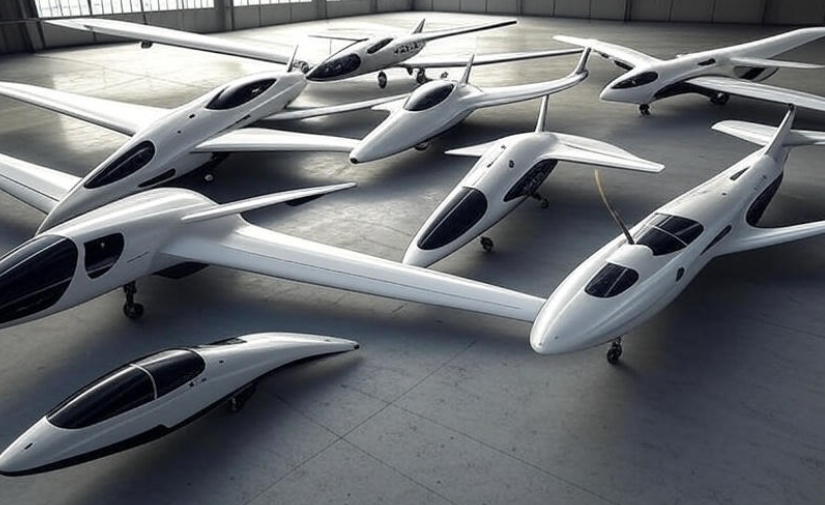Aviation has always been about pushing boundaries. From the Wright brothers’ first flight to today’s supersonic jets, innovation never stops. But now, we’re entering an era of designs that are truly revolutionary. These aircraft don’t just fly; they redefine what flying can be. Here’s a look at seven designs that are changing aviation as we know it.
1. Blended Wing Body Aircraft
Imagine an airplane where the wings and body merge into a single seamless structure. That’s the Blended Wing Body (BWB). Unlike traditional planes with a tube-shaped fuselage, BWB designs reduce drag and increase fuel efficiency dramatically. NASA and Boeing have been experimenting with prototypes, aiming to cut fuel consumption by up to 20–30%.
The BWB design isn’t just about efficiency. Its spacious interior allows for more passenger comfort. You could see lounges, bigger aisles, and even customizable cabin layouts in the future.
2. Electric Vertical Takeoff and Landing (eVTOL) Aircraft
eVTOLs are the stuff of science fiction—but they’re here. These aircraft take off and land like helicopters but fly like planes. Powered entirely by electricity, they aim to revolutionize urban air mobility. Companies like Joby Aviation and Lilium are leading the way, promising quiet, eco-friendly flights over cities.
Think about avoiding traffic jams by flying 500 meters above the ground. 🚁 eVTOLs could reduce commuting times drastically while cutting carbon emissions. They’re small, fast, and surprisingly efficient.
3. Supersonic Business Jets
The Concorde may be gone, but supersonic travel isn’t dead. New supersonic jets are lighter, quieter, and more fuel-efficient than their predecessors. Boom Supersonic’s Overture and Aerion AS2 are two examples designed to bring back supersonic passenger travel.
Flying at twice the speed of sound, these jets can cut international travel in half. Imagine New York to London in just 3–4 hours! ✈️
4. Hydrogen-Powered Aircraft
Hydrogen fuel isn’t just a buzzword—it’s the future of eco-friendly aviation. Unlike jet fuel, hydrogen produces zero carbon emissions. Airbus is working on three hydrogen-powered concepts named ZEROe, which could enter commercial service by 2035.
Hydrogen planes promise cleaner skies, quieter engines, and long-term sustainability. The challenge? Building the fueling infrastructure and designing safe, lightweight storage for the hydrogen tanks.
5. Morphing Wing Aircraft
Traditional wings are fixed, but what if they could change shape mid-flight? Morphing wings adapt to different flight conditions, improving efficiency and performance. DARPA and several aviation startups are experimenting with this tech.
These wings can extend, retract, or twist to reduce drag or increase lift. It’s like giving a plane superpowers: faster takeoffs, smoother cruising, and safer landings. 🛫
6. Electric Regional Aircraft
Short-haul flights could soon go fully electric. Aircraft like the Eviation Alice are designed to carry 9–12 passengers for regional trips with zero emissions. Electric regional aircraft can drastically cut operational costs, reduce noise pollution, and make flying more sustainable.
Regional airports may become more connected, offering quicker and cheaper alternatives to long drives or trains. Plus, they’re much quieter, which makes them city-friendly.
-
Related article: Why Pilots Trust Autopilot More Than You Think
7. VTOL Urban Air Taxis
Urban air taxis take eVTOL to the next level. Companies like Volocopter and Archer are designing aircraft specifically for dense city travel. These flying taxis aim to reduce road traffic, offering point-to-point transportation with minimal environmental impact.
Picture summoning a flying car via an app—your taxi arrives on a rooftop pad. You hop in, and in minutes, you’re across town. It’s no longer science fiction; it’s imminent. 🚖
Comparison Table of Revolutionary Aircraft Designs
| Aircraft Type | Key Feature | Advantage | Example Company | Flight Range |
|---|---|---|---|---|
| Blended Wing Body | Integrated fuselage & wings | Fuel efficiency, passenger comfort | NASA, Boeing | Long-haul |
| eVTOL | Electric vertical takeoff & landing | Urban mobility, zero emissions | Joby, Lilium | 50–150 km |
| Supersonic Jet | Mach 2+ speed | Half travel time | Boom, Aerion | Long-haul |
| Hydrogen-Powered | Zero carbon emissions | Eco-friendly | Airbus ZEROe | Medium-haul |
| Morphing Wing | Shape-changing wings | Improved performance | DARPA | Experimental |
| Electric Regional | Fully electric | Short-haul, low cost | Eviation Alice | 300–500 km |
| VTOL Air Taxi | Urban point-to-point flight | Reduce congestion | Volocopter, Archer | 50 km |
FAQs About Revolutionary Aircraft Designs
Q1: Are these aircraft safe?
Yes! Every design goes through rigorous testing. Electric and hydrogen aircraft also undergo extensive safety protocols before commercial deployment.
Q2: When will these planes be available commercially?
Some eVTOL and electric aircraft are expected to operate commercially in the next 3–5 years. Supersonic and hydrogen planes may take longer—closer to 2030–2035.
Q3: Will these aircraft be expensive to fly?
Initially, yes. But as technology scales, prices are expected to drop. Electric and hydrogen planes, in particular, promise lower operational costs over time.
Q4: Can these designs reduce environmental impact?
Absolutely. Electric, hydrogen, and advanced aerodynamic designs focus on fuel efficiency and emission reduction. Some could cut aviation emissions by 50% or more.
Q5: Do these planes require special airports?
Not all. eVTOLs and urban air taxis need vertiports (takeoff/landing pads). Hydrogen planes may need special fueling stations. Traditional airports can usually adapt for BWB, supersonic, and electric regional planes.
Final Thoughts
The future of aviation is incredibly exciting. These revolutionary aircraft designs are reshaping how we travel, making it faster, greener, and more comfortable. Whether it’s soaring above city traffic in an eVTOL or crossing the Atlantic in a supersonic jet, flying is about to change in ways most of us could only dream of a decade ago.
The sky isn’t the limit anymore—it’s just the beginning. 🌍✈️

